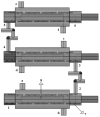Polymorphism and Microstructural Changes in Avocado Pulp (Persea americana Mill.) After Scraped-Surface Heat Exchanger Processing
- PMID: 39682789
- PMCID: PMC11640314
- DOI: 10.3390/foods13233717
Polymorphism and Microstructural Changes in Avocado Pulp (Persea americana Mill.) After Scraped-Surface Heat Exchanger Processing
Abstract
Avocado (Persea americana Mill.) is a fruit with a high content of unsaturated fatty acids and bioactive compounds, whose consumption has considerably increased in the USA and Europe. Thus, the conservation of the avocado mesocarp (pulp) has become more relevant. Avocado pulp was processed using a scraped-surface heat exchanger (SSHE) system to extend the shelf-life of the mesocarp. Through analysis with X-ray diffraction and HRTEM, it was possible to identify crystalline-type structures in the avocado pulp processed and stored at 4 °C. The 2θ-angles and d-spacing of the structures that reported the highest diffraction intensity are comparable to the polymorphs β' reported in the literature for fatty acid mixtures processed under similar conditions. Furthermore, the X-ray signals suggest the presence of polymorphs α and β in all samples processed and stored at different temperatures. Calorimetry analysis showed curves with first-order phase changes as indicative of crystallization-type transitions. The shelf-life evaluation of the avocado pulp showed that the crystallization process minimized the losses of antioxidant capacity and prevented color change, while the enzyme polyphenol oxidase remained inactivated. The changes induced by the SSHE continuous processing applied might represent an alternative to obtaining avocado products that preserve avocado's properties and extend its shelf-life.
Keywords: HRTEM; X-ray diffraction; avocado; polymorphism; scraped-surface heat exchanger.
Conflict of interest statement
The authors declare no conflicts of interest.
Figures








Similar articles
-
Differential Efficacy of Storage Temperature and Postharvest Treatment on Shelf Life and Quality of Avocado Fruit (Persea americana Mill.).Plant Foods Hum Nutr. 2024 Sep;79(3):669-676. doi: 10.1007/s11130-024-01207-5. Epub 2024 Jul 6. Plant Foods Hum Nutr. 2024. PMID: 38969792
-
Dietary intervention with avocado (Persea americana Mill.) ameliorates intestinal inflammation induced by TNBS in rats.Inflammopharmacology. 2023 Feb;31(1):485-498. doi: 10.1007/s10787-022-01128-2. Epub 2022 Dec 31. Inflammopharmacology. 2023. PMID: 36586042
-
Bioactive Molecules From Native Mexican Avocado Fruit (Persea americana var. drymifolia): A Review.Plant Foods Hum Nutr. 2021 Jun;76(2):133-142. doi: 10.1007/s11130-021-00887-7. Epub 2021 Mar 11. Plant Foods Hum Nutr. 2021. PMID: 33704631 Review.
-
Characterization, Quantification and Quality Assessment of Avocado (Persea americana Mill.) Oils.Molecules. 2020 Mar 24;25(6):1453. doi: 10.3390/molecules25061453. Molecules. 2020. PMID: 32213805 Free PMC article.
-
The Pulp, Peel, Seed, and Food Products of Persea americana as Sources of Bioactive Phytochemicals with Cardioprotective Properties: A Review.Int J Mol Sci. 2024 Dec 19;25(24):13622. doi: 10.3390/ijms252413622. Int J Mol Sci. 2024. PMID: 39769384 Free PMC article. Review.
References
-
- King-Loeza Y., Ciprián-Macías D.A., Cardador-Martínez A., Martín-del-Campo S.T., Castañeda-Saucedo M.C., del Pilar Ramírez-Anaya J. Functional Composition of Avocado (Persea americana Mill. Var Hass) Pulp, Extra Virgin Oil, and Residues Is Affected by Fruit Commercial Classification. J. Agric. Food Res. 2023;12:100573. doi: 10.1016/j.jafr.2023.100573. - DOI
-
- Tan C.X., Tan S.S., Tan S.T. Influence of Geographical Origins on the Physicochemical Properties of Hass Avocado Oil. JAOCS J. Am. Oil Chem. Soc. 2017;94:1431–1437. doi: 10.1007/s11746-017-3042-7. - DOI
-
- Cárdenas-Castro A.P., Fernández-Ochoa Á., Cádiz-Gurrea M.d.l.L., Segura Carretero A., Sáyago-Ayerdi S.G. Bioactive Phytochemicals from Vegetable Oil and Oilseed Processing By-Products. Volume 1. Springer Nature; Berlin/Heidelberg, Germany: 2023. Bioactive Phytochemicals from Avocado Oil Processing By-Products; pp. 403–430. Reference Series in Phytochemistry.
-
- Nguyen V.L., Tran T.D., Bui T.H., Paxayavong S., Tran T.L.H. Bioactive Compounds, Antioxidant Activity and Lipid Content of Various Avocado Fruits. Carpathian J. Food Sci. Technol. 2022;14:36–47. doi: 10.34302/CRPJFST/2022.14.2.4. - DOI
Grants and funding
LinkOut - more resources
Full Text Sources

